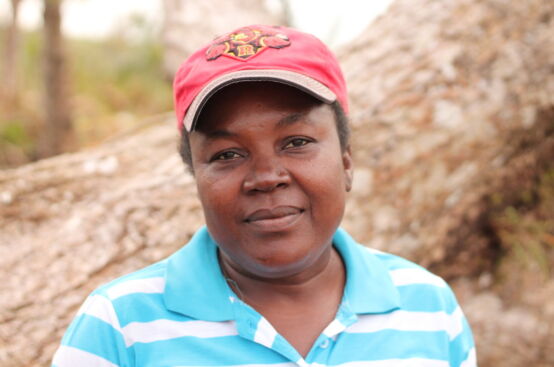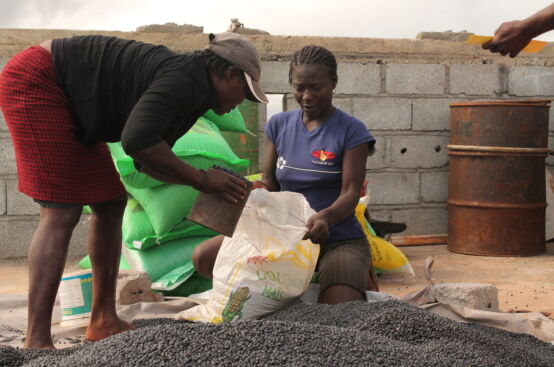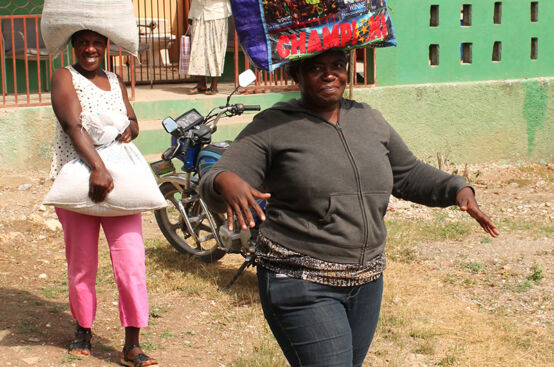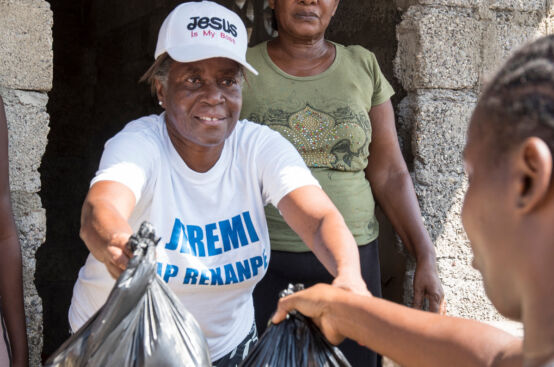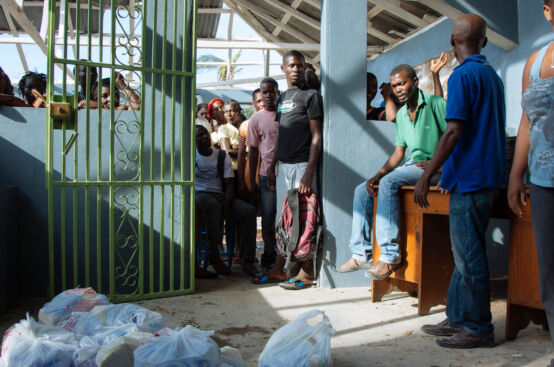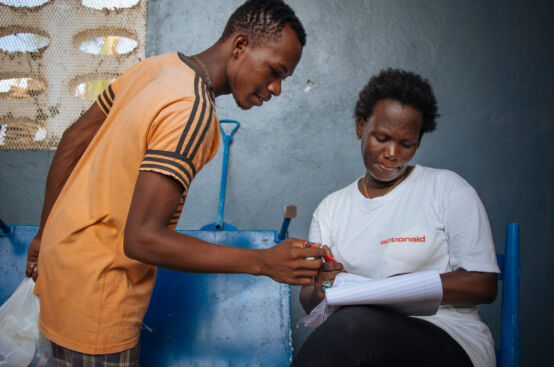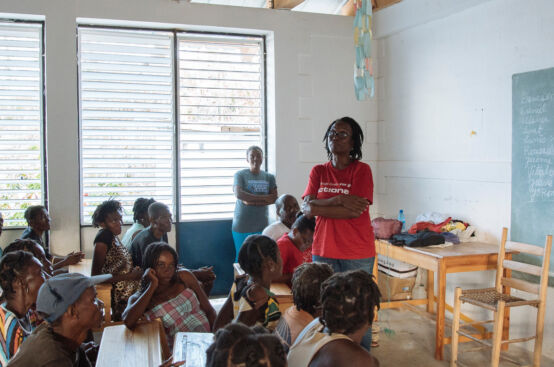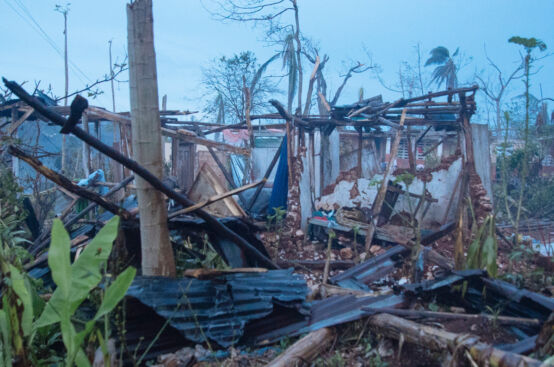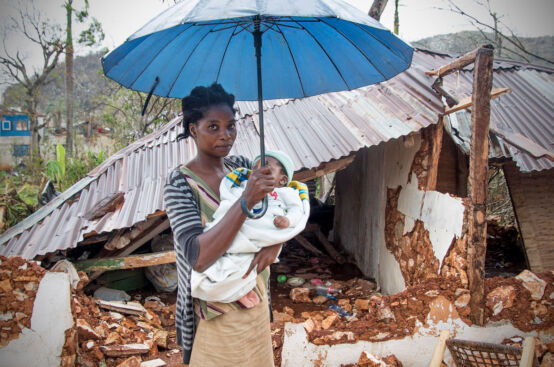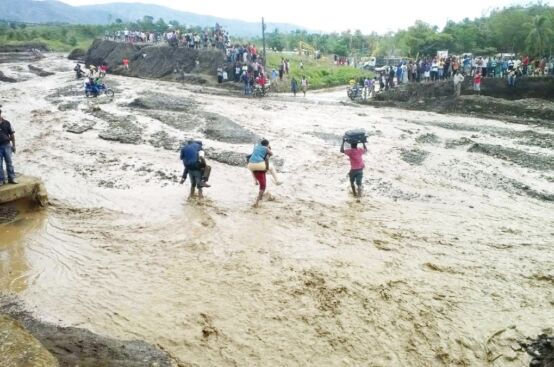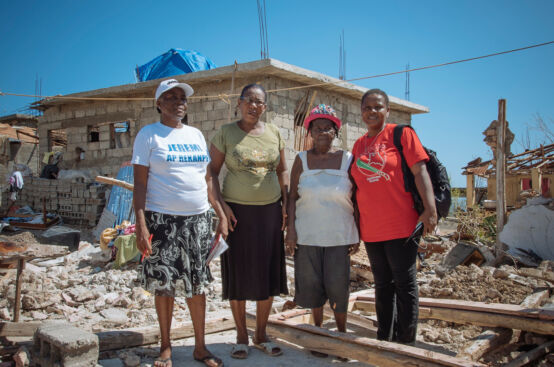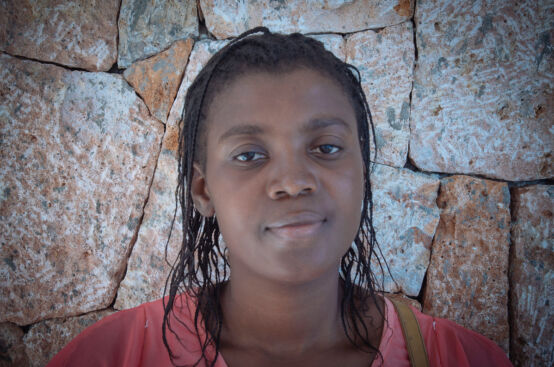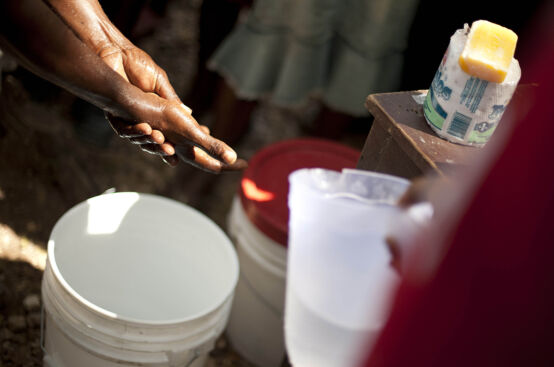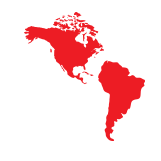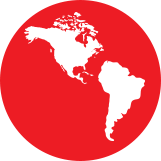On October 4, 2016, Hurricane Matthew struck southwest Haiti. This category 5 storm brought with it 145 mph winds, making it the strongest storm to hit Haiti in the last 50 years.
More than 1,000 people lost their lives and 200,000 homes were destroyed. But the damage didn’t stop there.
It’s estimated that it will take years for people hardest hit to recover from the latest natural disaster to hit one of the world’s poorest countries. Fresh water supplies were contaminated as floods from the storm washed dirty water inland, leaving many people without clean drinking water. Many of the same people were left without food to eat, with the two departments hardest hit – Grand’Anse and Sud – experiencing almost complete crop damage.
Our local Haitian staff has worked in some of the worst affected areas, providing kits containing soap, chlorine tablets and hygiene kits that local volunteers distributed to 58,000 people. Experience tells us that women and girls are often vulnerable to sexual violence in the chaos that follows an emergency of this scale, so we set up four safe spaces for them. Four more are being constructed.
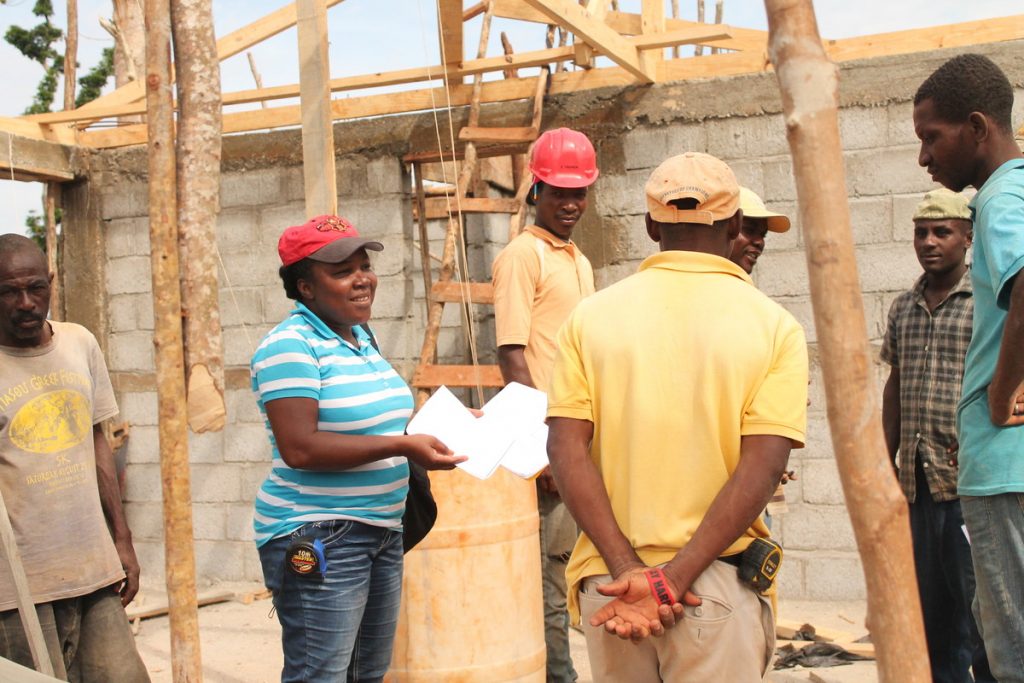
Civil engineer Ismène Elismar Garconnet oversaw construction of Women Friendly Spaces throughout Haiti. Photo: ActionAid
Just two months before Hurricane Matthew, our staff in Haiti trained a group of 30 women leaders from different communities on how to coordinate an emergency response. When the hurricane hit, they were ready to respond quickly. In the hardest-hit regions, they delivered “first response kits” containing food, water, and soap to 2,804 families.
Civil engineer, social worker, and feminist Ismène Elismar Garconnet has worked with ActionAid Haiti since 2015 to help train “local women to become community leaders in emergencies.”
A native of Port-au-Prince, Ismène also spearheaded the construction of Women Friendly Spaces throughout Haiti and worked with ActionAid to monitor the project.
“There is a sense of responsibility that I feel when I see the devastation. I know that my skills would be useful, just like after the 2010 earthquake.”
– Ismène Elismar Garconnet, engineer & social worker
Ismène has also trained women to respond to gender-based discrimination and sexual violence, and she meets one-on-one with those who have reported more serious cases.
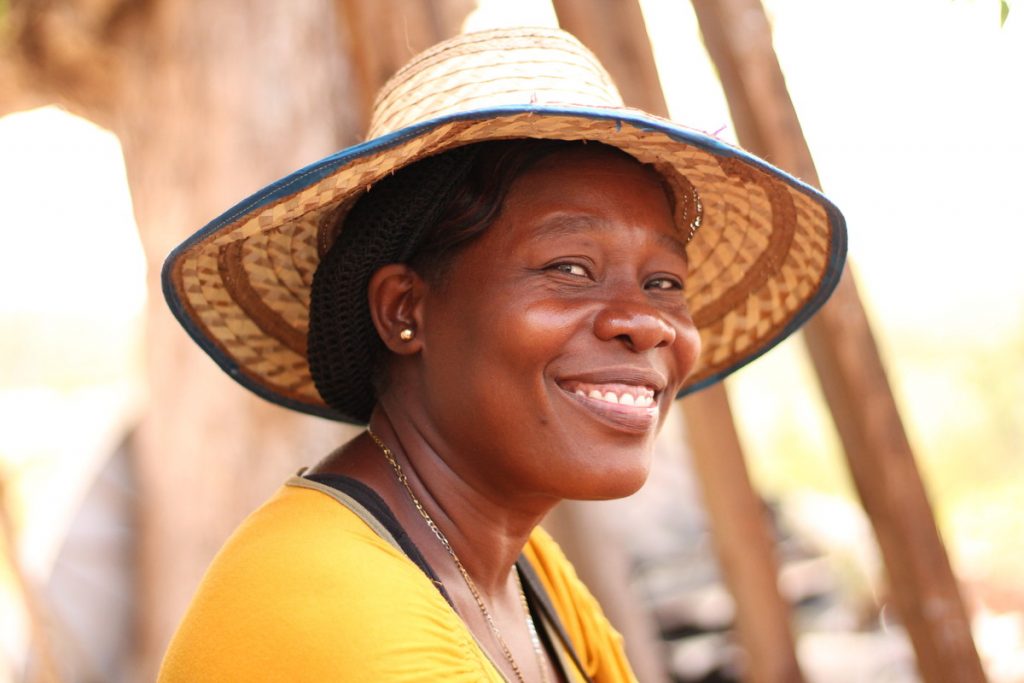
Food distribution volunteer Rosianne Fortilus made sure everyone got equal amounts of seeds and beans.
Along with ensuring women’s safety, revitalizing local agriculture has been crucial to helping people rebuild their lives. In Grand’Anse, where more than 90% of crops were destroyed in the hurricane, ActionAid partnered with RELAZA, a local social and economic organization, to distribute seeds. RELAZA member Rosianne Fortilus made sure everyone who went to the seed distribution got equal amounts of seeds and beans.
“The seeds are to help the community get back on their feet after the hurricane. It was clear that everyone got the same, so the distribution was fair. I also received seeds like everyone else.”
– Rosianne Fortilus, seed distribution volunteer
At the seed fair, volunteers like Rosianne measure out the seeds and beans in front of each participant so that everyone sees that the process is open and fair. In November 2016, 742 households received seeds for the winter growing season. Three months later, 372 additional households received seeds for the spring such as black beans, sweet potatoes, and eggplant. Seed packages include 1,000 gourdes (about US$15) in cash that could be used as the recipient saw fit, such as for purchasing food as they wait for their new crops to grow.
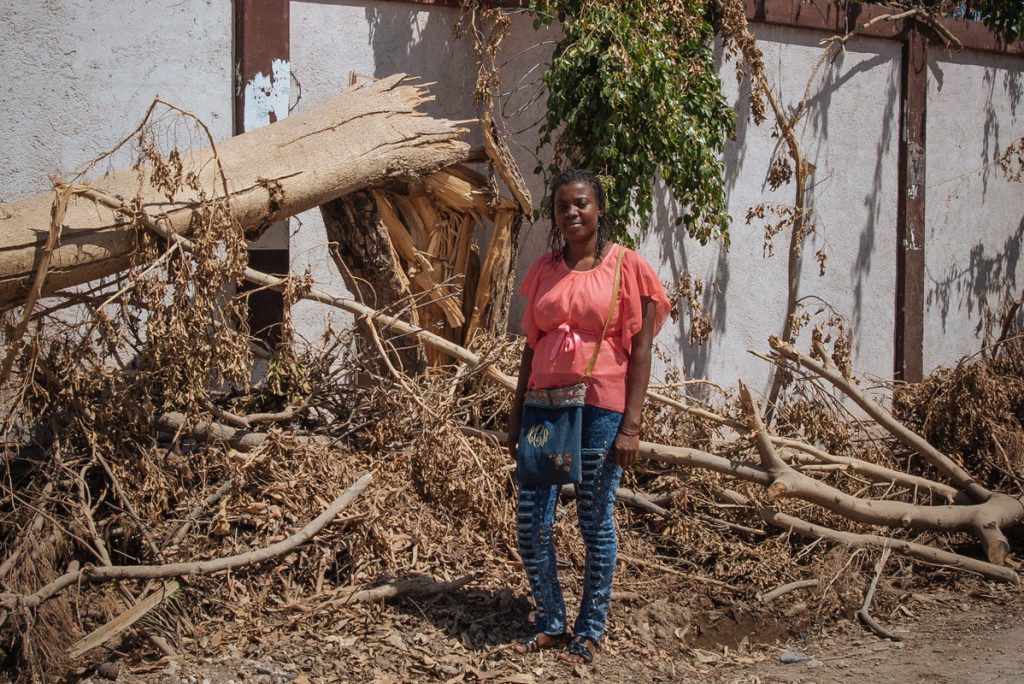
Joanne is a leader from Femmes En Action, a woman’s group supported by ActionAid through our local partner KPGA. Photo: Dylan Roberts/FreeSociety/ActionAid
Joanne Moise is a mom of two from Jérémie in Grand’Anse. Her house was completely destroyed when the hurricane hit at 4 a.m. She fled to a nearby church with her kids to seek shelter as the winds swirled around them.
“We were very scared. When we saw that the hurricane was really bad, we got together as a family to see how we can resist the hurricane. We are used to doing this when the winds are strong, but they have never been anywhere near this bad before.
“My husband took our son and I took our baby daughter. We held them under our stomach to try to protect them from the winds.
“When we got there we looked back at our house and it had gone. At that point we all burst into tears. It was so terrible. We cried so loudly. Our home. Our home was gone.”
While they were sheltering at the church, it also collapsed. But the family was saved by members of the community who formed a rescue committee to support the most vulnerable people in their community and get them to safety.
Now that the storm has passed and the clear up has started, powerful problem solvers like Joanne are working to get their communities back on their feet again.
Joanne is a leader within her community and is part of a program set up by local Haitians together with ActionAid so that local people can better understand and claim their rights.
“We have a program called ‘Solidarité’. So if one member of the group has a problem, it is a shared problem, and we all help to solve it.
“We visit everyone, because the hurricane hit everyone. So we’re fighting to make women’s lives better. Because as you know, when we have this kind of disaster it hurts the women particularly badly.
“I really love my community. I love it. That’s why I stay there. I don’t want to move anywhere else.”
Haitian-led recovery
Ismène, Rosianne, and Joanne are clear examples of how local problem solvers within their community are supporting the people around them in the aftermath of this disaster – in contrast to the 2010 Haiti earthquake. The 2010 rebuild operation was called “Build Back Better”, but the reality was very different for most Haitians. They saw their opinions and rights ignored, as people from around the world rushed in to tell them how they should rebuild their country.
Billions of dollars in emergency aid money were squandered. And the Haitian people were the ones that suffered. As aid money starts to arrive in Haiti once again, these mistakes cannot be repeated. The Hurricane Matthew response must be Haitian-led.
For this to happen, donors – governments, companies and individuals alike – must make sure their money goes to an organization that can reach those people in greatest need. They should be asking questions like is the organization connected to local people? Do their staff speak Creole rather than French? And do they have the right relationships in place to be able to do the work?
Some donors are embracing this new approach of putting local people first, and they’re starting to see the results.
Local people understand their context better than we ever can, and they’re determined and committed, and motivated to change the world around them. That’s why organizations like ActionAid are investing in local problem solvers – powerful people who live in communities like those hardest hit in Haiti by Hurricane Matthew, who are mobilizing others to use the resources we supply and will continue to do so.
By actively investing in local people and the solutions they develop, we can make sure that communities in Haiti are better prepared to face such disasters in the future.

